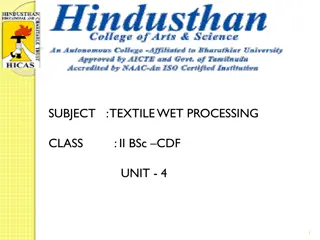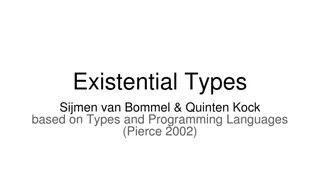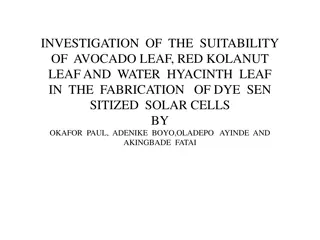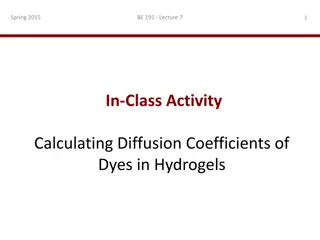Preparation of 2,3-Diphenyl quinoxaline
Quinoxaline, an organic compound, is synthesized through the condensation of benzyl with 1,2-phenylene diamine in this practical organic chemistry experiment at Salahaddin University. Quinoxaline and its derivatives have various applications in dyes, pharmaceuticals, and antibiotics. The process inv
0 views • 9 slides
Understanding Blood Groups and Their Significance
Human blood types are determined by specific antigens and antibodies present on red blood cells, influencing crucial aspects like blood transfusions and familial relationships in forensic medicine. The ABO system, with its four main blood types (A, B, AB, O), plays a vital role in categorizing blood
7 views • 14 slides
Evolution of Histochemistry: A Journey Through Scientific Breakthroughs
Delve into the historical review of histochemistry, exploring its roots in the assessment of chemical compounds within cells and tissues using stains and dyes. Uncover the classification of histochemical methods, from chemical to biological approaches, and gain insights into the development and goal
0 views • 16 slides
Understanding Dyes: Classification and Chemistry in Chemistry Department of Sevadal Mahila Mahavidyalaya
Dyes are organic compounds that impart color to various substrates. Dr. P. P. Chahande presents an in-depth look into dyes, including their classification based on source material and chemical structure. Natural and synthetic dyes are explored, along with a breakdown of different chemical classifica
1 views • 17 slides
Understanding Fluorescence Microscopy: Principles and Applications
Fluorescence microscopy, pioneered by British scientist Sir George G. Stokes, reveals hidden details in specimens using fluorescent dyes that emit light of longer wavelengths. This innovative technique allows for visualization of cellular components that are otherwise colorless under conventional mi
0 views • 19 slides
Understanding Instruction Set Architecture and Data Types in Computer Systems
In computer architecture, the Instruction Set Architecture (ISA) level is crucial in defining how a processor executes instructions. This includes the formal defining documents, memory models, registers, and various data types that can be supported. The ISA level specifies the capabilities of a proc
2 views • 13 slides
Understanding Hotel Classification and Types
Hotel classification and types cover various aspects such as facilities, services, amenities, guest types, and factors influencing hotel classification. From resort hotels to airport hotels and city center accommodations, each hotel type serves different purposes and caters to diverse guest preferen
0 views • 44 slides
Comprehensive Guide to Wound Care: Types, Dressings, and Practices
Understanding wound care is crucial for proper healing. This guide covers types of wounds, purposes of wound dressing, different dressing types, and helpful practice guidelines. Learn about intentional and unintentional wounds, dressing purposes like protection and absorption, and types of dressings
1 views • 10 slides
Understanding Contract Types and Incentives Under ProTech
Explore the factors influencing contract types selection, including price competition, cost analysis, and technical capability. Learn about different contract types like fixed-price and cost-reimbursable, each with unique characteristics and risks. Discover the spectrum of contract types and incenti
0 views • 21 slides
Bacteria Identification Techniques: Staining and Microscopy Overview
Staining techniques in microbiology play a crucial role in visualizing bacteria under microscopes. This content covers the importance of staining, types of dyes, wet and dry mounts, hanging drop technique, and different types of staining methods employed in identifying bacteria. Explore the basics o
0 views • 39 slides
Coffee Filter Chromatography in Elementary School Science Presentation
Discover the fascinating world of chromatography through an engaging elementary school science presentation. Learn about mixtures, separation techniques, and the process of paper chromatography using food coloring dyes. Explore how chromatography can separate different components in mixtures and wit
0 views • 10 slides
Exploring C Program Refinement Types with Liquid Types and Invariant Discovery
Discover the integration of Liquid Types and Refinement Types in C programming through Invariant Discovery, leading to automatically adapting C programs to fit Liquid Types. Explore challenges and solutions in expressing invariants, handling unknown aliasing, and implementing strong updates within t
0 views • 24 slides
Atlas HR eServices - Leave Types and Application Procedures
This content provides detailed information on various leave types and application procedures within the Atlas HR eServices platform. It covers topics such as Jury Duty Leave, Compensatory Day Off, Floating Holiday (NY), Official Business, Rest & Recuperation, along with guidelines on how to apply fo
0 views • 12 slides
Exploring Natural Dyes in Textile Wet Processing
Natural dyes, sourced from plants, minerals, and animals, have made a resurgence in textile dyeing due to environmental concerns. This online class covers the origin, classification, and characteristics of natural dyes such as Indigo, Indian Madder, Turmeric, Marigold, Henna, Tea, and Onion. Discove
0 views • 18 slides
Sawdust as a Low-Cost Adsorbent for Water Treatment
Sawdust, a renewable natural resource, has been studied for its effectiveness as an adsorbent for removing contaminants from water. It contains cellulose, hemicellulose, lignin, and other components that aid in adsorption. Research indicates its suitability for removing dyes, toxic salts, and heavy
0 views • 22 slides
Understanding Existential Types and Type Manipulation in Programming Languages
Explore the concepts of existential types, type abstraction, type ambiguity, packing, and unpacking in the context of programming languages. Learn how to work with hidden types, universal types, and the nuances of type manipulation. Examples and illustrations are provided to enhance understanding.
0 views • 17 slides
Investigation of Avocado, Red Kolanut, and Water Hyacinth Leaves for Dye Sensitized Solar Cells
This study explores the potential of using natural plant dyes from avocado leaf, red kolanut leaf, and water hyacinth leaf in fabricating dye sensitized solar cells (DSSCs). The introduction discusses the need for alternative energy sources due to global warming, with DSSCs offering a low-cost and e
0 views • 34 slides
Campus Journals and General Ledger Overview
Campus Journals in September 2014 cover various topics such as Icebreaker activities, Ground Rules, Safety procedures, Disclaimers, Class Format, Agenda for the session, Campus Journal types, and Transaction Types. The content includes descriptions of different journal types and transaction types, a
0 views • 43 slides
Analysis of Absorption Properties of Conjugated Dyes
The analysis focuses on the absorption properties of conjugated dyes such as 1,1-diethyl-2,2-cyanine iodide (red), 1,1-diethyl-2,2-carbocyanine iodide (blue), and 1,1-diethyl-2,2-dicarbocyanine iodide (turquoise). It involves calculating lambda max for each dye based on a particle in a box model, co
0 views • 15 slides
Understanding Precipitation: Forms and Types Explained
Precipitation, any form of moisture reaching Earth's surface from the atmosphere, encompasses various types like rain, snow, drizzle, glaze, sleet, and hail. Each type has unique characteristics, densities, and formation processes. Additionally, precipitation can be classified into convection, cyclo
1 views • 38 slides
Optimised Live/Dead Fluorescence Spectrometry for Antimicrobial Susceptibility Testing
This study focuses on the optimisation of live/dead fluorescence spectrometry for rapid antimicrobial susceptibility testing. The research uses fluorescent dyes to distinguish between live and dead cells, providing a potential method for quick antimicrobial resistance diagnostics. The experiment inv
0 views • 16 slides
Understanding Java Data Types and Variable Declaration
Dive into the world of Java data types and variable declaration with this comprehensive guide. Learn about primitive data types, declaring variables, integer types, floating-point data types, character data type, and boolean data type. Master the art of assigning names and data types to efficiently
0 views • 31 slides
Understanding Dye-Sensitized Solar Cells and Types of Dyes in Solar Cell Technology
Explore the world of dye-sensitized solar cells and the various types of dyes used in these innovative solar energy technologies. Discover the difference between metal-complexes and organic dyes, learn about the advantages and disadvantages of different dyes, and delve into the absorption spectra of
0 views • 16 slides
Understanding Diffusion Coefficients of Dyes in Hydrogels
Explore the calculation of diffusion coefficients of dyes in hydrogels based on factors like molecular weight, matrix mesh size, temperature, and chemical properties. Learn through in-class activities to determine the diffusion coefficients in different hydrogel concentrations, assess the applicabil
0 views • 6 slides
Understanding Vat Dyes: Properties, Dyeing Process, and Limitations
Vat dyes are known for providing excellent color and fastness properties to textile materials, especially natural and manmade fibers. The dyeing process involves steps like aqueous dispersion, vatting, absorption by fibers, re-oxidation, and soaping off to ensure colorfastness. However, there are ce
0 views • 25 slides
Advancements in Dye-Sensitized Photoelectrochemical Cells
History traces the development of photoelectrochemical cells since 1972, highlighting the progress, challenges, and state-of-the-art dyes used, with an emphasis on improving performance through innovative solutions like Al2O3 layers. Key issues such as dye degradation and electron-hole recombination
0 views • 15 slides
Understanding the Principles of Staining in Histopathology
Staining is a crucial technique in histopathology that involves adding specific dyes to biological substrates to visualize and differentiate cell and tissue components. This chapter covers the principles of staining, types of stains used, factors influencing staining affinity, and common stains empl
0 views • 43 slides
Non-Isotopic Labeling for Molecular Detection
The use of non-radioactive probes in molecular detection involves synthetic DNA or RNA molecules with specific target sequences and reporter groups detectable via fluorescence spectroscopy. Direct and indirect labeling methods utilize fluorescent dyes or enzymes conjugated to modified nucleotides, a
0 views • 20 slides
Gel Electrophoresis for Assessing Nucleic Acid Quality
Gel electrophoresis is a crucial technique for assessing the quality and yield of nucleic acids such as DNA and RNA. It separates DNA fragments based on size, allowing researchers to determine the integrity of the nucleic acids. By running a small amount of sample on a gel and using DNA-binding dyes
0 views • 9 slides
Evolution of Chemical Industry from Coal Tar to Environmental Regulations
The story traces the evolution of the chemical industry from the discovery of coal tar in 1856 to the development of aniline dyes, resulting in the growth of major chemical companies. However, the environmental impact became a concern, leading to the Toms River Superfund Site and the implementation
0 views • 31 slides
GCSE Separation Challenge: Iron, Sulfur, Sand, and Food Dyes Mixture
Students are tasked with separating a mixture containing iron, sulfur, sand, and food dyes using various techniques. They work in pairs, following provided instructions and using specific equipment. Marks are awarded based on successful separation and organization. The challenge involves planning, e
0 views • 8 slides
Understanding the Staining Process in Microscopy
Staining is a vital technique in microscopy to enhance contrast and highlight structures in biological samples. Dyes and stains, with their specific chemical properties, play a key role in this process. The classification of dyes into acidic, basic, and neutral categories based on their chemical beh
0 views • 17 slides
Effects of Toxic Materials in Device Fabrication and Environmentally Friendly DSSC Options
Negative effects of toxic materials used in device fabrication processes include reproductive health issues, cancer risks, and respiratory abnormalities for workers. Dye Sensitized Solar Cells (DSSC) present a more cost-effective and simpler alternative to silicon solar cells, with metal sensitizers
0 views • 17 slides
Innovative Solutions for Pollution Control Using Natural Adsorbents
Workshop explores new trends in biotechnology for pollutant removal. Focus on adsorption of dyes onto low-cost adsorbents, with analysis of equilibrium state. Various techniques discussed include bioaccumulation, biosorption, and use of non-living biomasses. Emphasis on eco-friendly filtering techni
0 views • 18 slides
Data Types, Expressions, and Operators in Java
This resource provides information on data types, expressions, and operators in Java. It covers topics such as data types (int, double, String, boolean), operator precedence, and practice problems to work on expressions and types. The content includes announcements, reminders, a recap of data types,
0 views • 20 slides
Understanding Haskell Types, Classes, Functions, and Polymorphism
In Haskell, types are collections of related values, ensuring type safety through compile-time type inference. Type errors occur when functions are applied to arguments of the wrong type. Annotations help define types, and Haskell offers basic types like Bool, Char, String, Int, Integer, Float, and
0 views • 30 slides
Understanding Types and Classes in Haskell Programming
Types in Haskell are names for collections of related values, allowing for safer and faster programs by catching errors at compile time. Haskell supports basic types like Bool, Char, String, Int, Integer, and Float, as well as list and tuple types. Type errors occur when functions are applied to arg
0 views • 27 slides
Introduction to Python Data Types, Operators, and Expressions
Understanding data types, expressions, and operators is fundamental in Python programming. Learn about Python's principal built-in types such as numerics, sequences, mappings, and classes. Explore numeric types, strings, and their operations like concatenation, escape sequences, and conversions betw
0 views • 20 slides
Challenges and Opportunities in Handloom Weaving Innovation
Exploring the intersection of tradition and modernity in handloom weaving, this content delves into the challenges faced by the industry, such as sustainability and innovation. It highlights initiatives like adapting reactive dyes, inventing natural dyes, and the need for modernization and education
0 views • 30 slides
Mongibello ARTISANPASTA – Handcrafted Pasta for Discerning Tastes
Mongibello ARTISANPASTA is dedicated to creating unique, high-quality pastas without additives or preservatives. Led by owner Shel Rheingold and manager Stefan Linn, their team crafts innovative flavors using all-natural dyes and minimal die-cut processes. From Zesty Black Bean Fettuccini to Shel's
0 views • 6 slides







































